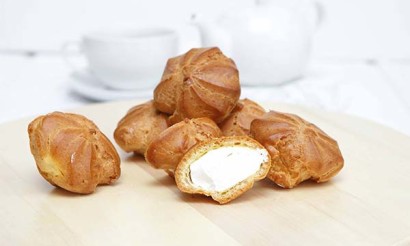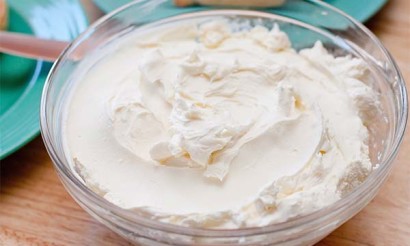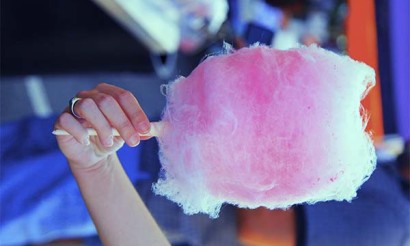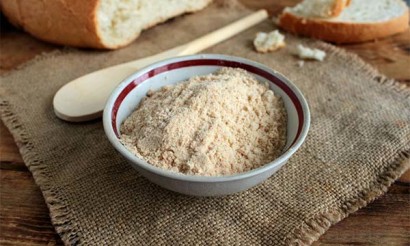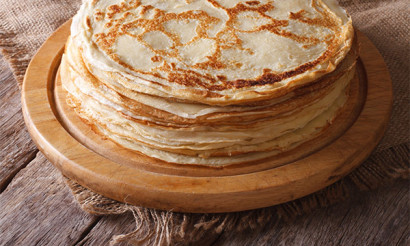How to bake biscuits in the oven: temperature, time and mode
Despite the simplicity of making biscuits, they do not always turn out puffy and baked. Among the main reasons for blunders, professionals single out different temperature of the ingredients, violation of proportions, improper whipping. It is especially important when cooking to observe the temperature mode, which directly affects the uniformity of heat treatment of dough, the appearance, taste of baked goods.
- How temperature affects the biscuit
- Temperature, time and mode of baking biscuits
- In an electric oven
- In a gas oven
- A Q&A
- At what level should I bake biscuits in the oven?
- Do I need to turn on convection when baking a biscuit?
- In which oven should I put the biscuit: cold or hot?
- Can I open the oven while baking a biscuit?
- How do I take a biscuit out of the oven without it settling?
- How to check if the biscuit is ready?
- Why does the biscuit not bake inside?
- In what form to bake biscuits and what to grease it with?
- Why does the biscuit rise in a pile when baked?
How does the temperature affect the biscuit?
With biscuit dough placed in the oven, under the influence of high temperatures, metamorphoses occur. Gases expand to form bubbles, fats melt, sugar dissolves, and egg white coagulates. As a result of chemical and physical reactions, the dough turns into a puffy, porous biscuit.
At a relatively low temperature of 150°C, cooking takes longer but proceeds evenly. If the dough is placed in an oven heated to 200°C or higher, the crust will heat up faster than the crumb. The surface will caramelize quickly, acquire an unpleasant taste, rise in a slide or crack.
For biscuits cooked at t- 150°C, the crumb is soft and tender. Biscuits cooked at high temperatures have a coarser crumb. The reason for this is the different coagulation rate of the proteins.
Evenly baked and fluffy biscuits are obtained at 160-180 degrees. Keep in mind that every oven is individual, the temperature set and the actual temperature may differ, so it is recommended to use a digital or analog thermometer.
Temperature, time, and baking mode for biscuits
Time, mode of preparation of biscuit dough in an electric and gas oven is slightly different. The subtleties of baking depend on the method and uniformity of heat distribution.
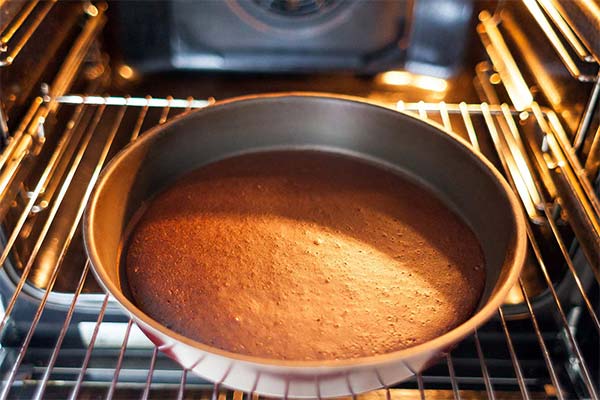
In an electric oven
The electric oven heats and cools slowly. This fact has a positive effect on the end result, excellent for baking, since temperature fluctuations are eliminated.
To bake the dough evenly, cook the biscuit for 45 minutes in the top-bottom mode at t- 160-170°C.
In a gas oven
A gas oven heats faster than an electric oven and is easier to control the temperature in it if you have a thermometer. But when the gas burns, moisture is released, causing the crust to fry. Gas oven can not provide even heating because of possible ignitions of gas.
Baking in it biscuit cakes is possible if you get used to the nuances of work. The optimal cooking time is 40 minutes at 180°C.
Q&A
Questions of novice cooks are related to the nuances of baking. Hostesses are interested in what, in what mode and on what level to bake biscuits, how to bake the dough evenly, to preserve the puffiness of the product after removing it from the oven.
At what level to bake biscuits in the oven?
To ensure that the heat is distributed most evenly when the oven is in top-bottom mode, place the biscuit dough mold in the middle of the middle level.
Do I need to use convection when baking biscuits?
If there is only one heating element in the oven and it is not possible to use the top and bottom heating modes at the same time, turn on the forced air circulation mode. Convection ensures the warming of the half-finished product from all sides. When using this mode, reduce the baking time by a quarter, the temperature by 10-15 degrees.
In which oven should I put the biscuit: cold or hot?
To avoid spoiling the biscuit by falling dough, preheat an empty electric oven 15 to 20 minutes before baking. The baking tray or mold must remain cold, or the cake will turn out stiff.
Can I open the oven while baking a biscuit?
The dough rises in the oven by coagulating the protein. This process occurs gradually with even heating. If you open the door, the temperature regime will be disturbed, the dough will settle and it will be impossible to correct it.
For the first 20-30 minutes it is better not to approach the oven. To check readiness, gently open the oven door when the dough has risen to its maximum, locking in place.
How do I take a biscuit out of the oven correctly so that it doesn't sag?
To prevent the biscuit from blowing away like a balloon from the sudden change in temperature, leave the product in the oven for 15-20 minutes. Open the door slightly to allow air to escape, gradually lowering the temperature. Do not keep biscuits in the oven longer than 20 minutes, as they may become soft from condensation or dry out.
After removing the biscuit from the parchment, turn it over and place it on a rack until it cools completely. If you transfer the finished product to a plate or cutting board, moisture will accumulate on the bottom surface and it will become sticky.
After 2 hours, cover the biscuit with clingfilm and place it in the refrigerator to stabilize.
How do I check if the biscuit is ready?
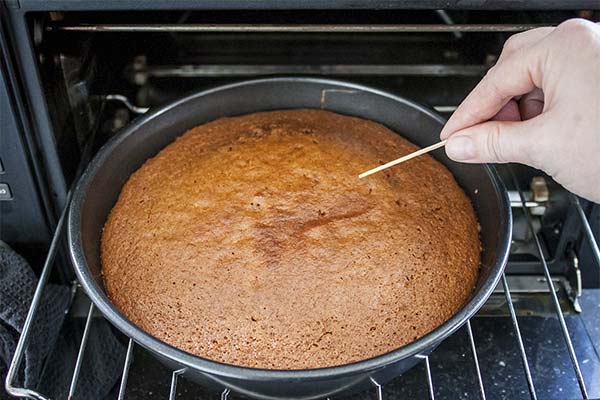
Be guided by the appearance of the product. A biscuit is considered ready if it has shrunk a little and moved away from the rims. A more reliable way to check readiness is to use a wooden stick, a toothpick. Pierce the biscuit in the center, assess the results. If the "tester" is dry, the oven can be turned off. Sticky end of the stick with dough residue indicates that the biscuit is still raw.
Why isn't the biscuit baking inside?
There are several reasons for uneven biscuit baking:
Temperature violations.
The biscuit stays soggy inside when cooked in an oven with a temperature higher or lower than recommended by the recipe.
In the first case, the heat quickly dries out the edges without reaching the center. At low temperatures, the dough doesn't have enough time to bake. It stays low and light without a yummy crust.
Check the temperature in the oven. If it is higher than normal, make it lower, cover the biscuit on top with foil, so that the crust does not finally burn, continue cooking. If it is low, add degrees.
Incorrectly beaten eggs.
If the recipe does not include a leavening agent, the dough becomes porous due to the coagulation of eggs. During preparation, the eggs are preheated to room temperature, whipped in a clean dry bowl, gradually increasing the speed of the mixer. Incorrectly beaten egg mass makes the biscuit rubbery, flat.
Incorrect proportions
Another cause of not baked biscuit is the result of a technological error. To a deplorable result leads to excessive sugar and flour, added in a larger or smaller volume than specified in the recipe.
Careless actions
Biscuit dough does not tolerate shaking, temperature changes. Do not unnecessarily rearrange the form with the contents, put carelessly on the grate, unnecessarily open the oven door unnecessarily. If you do not observe these rules, the air bubbles will burst, the middle will fail, will remain unbaked.
In what form to bake biscuits and what to grease it with?
The best form for biscuits is round, divided, with non-stick coating, high sides. A diameter of 24-26 cm is appropriate. It is not necessary to grease the non-stick coating. If the mold does not have this advantage, cut a circle out of parchment to cover the bottom, a strip slightly wider than the height of the rims.
Why does a biscuit rise in a pile when baked?
A biscuit rises as a slide if the heat is not evenly distributed or if it is cooked at high temperatures. It's easy to correct. Adjust the temperature with a thermometer, place an empty baking tray over the mold or cover the top with foil, making several holes in it. In the latter case, increase the baking time by 10 minutes.
The success of the final result depends largely on the temperature setting. If you are not sure about the work of your oven, buy a thermometer.
«Important: All information on this site is provided for informational purposes only purposes only. Before applying any recommendations, consult a professional oven keeper. specialist. Neither the editors nor the authors are liable for any possible harm caused by materials."


